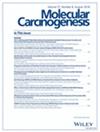Knockdown of PAIP1 Inhibits Breast Cancer Cell Proliferation by Regulating Cyclin E2 mRNA Stability
IF 3.2
2区 医学
Q3 BIOCHEMISTRY & MOLECULAR BIOLOGY
引用次数: 0
Abstract
Polyadenylate‐binding protein‐interacting protein 1 (PAIP1) is a protein that modulates translation initiation in eukaryotic cells. Studies have shown that PAIP1 was overexpressed in various type of cancers, and drives cancer progression by promoting cancer cell proliferation, invasion, and migration. In our previous study, we identified that PAIP1 was overexpressed in breast cancer, and the expression was correlated with poor prognosis. However, the biological function of PAIP1 in breast cancer has not been clearly understood. In this study, we constructed PAIP1 specifically silenced breast cancer cells. Then, cell proliferation, cell cycle distribution, and apoptosis were detected in PAIP1 knockdown cells. RNA‐seq analysis was performed to predict the downstream target of PAIP1, and the molecular mechanism was explored. As a results, we found that knockdown of PAIP1 repressed cell proliferation, induced cell cycle arrest, and triggers apoptosis. Xenograft mouse model showed that knockdown of PAIP1 inhibits cell growth in vivo. RNA‐seq predicted that敲除 PAIP1 可通过调节 Cyclin E2 mRNA 稳定性抑制乳腺癌细胞增殖
多聚腺苷酸结合蛋白相互作用蛋白 1(PAIP1)是一种调节真核细胞翻译起始的蛋白。研究表明,PAIP1 在多种癌症中过表达,并通过促进癌细胞增殖、侵袭和迁移来推动癌症进展。在我们之前的研究中,我们发现 PAIP1 在乳腺癌中过表达,并且其表达与不良预后相关。然而,PAIP1 在乳腺癌中的生物学功能尚不清楚。在本研究中,我们构建了特异性沉默 PAIP1 的乳腺癌细胞。然后,检测了 PAIP1 敲除细胞的细胞增殖、细胞周期分布和细胞凋亡。通过RNA-seq分析预测了PAIP1的下游靶标,并探讨了其分子机制。结果发现,敲除 PAIP1 可抑制细胞增殖、诱导细胞周期停滞并引发细胞凋亡。异种移植小鼠模型显示,敲除 PAIP1 可抑制体内细胞生长。RNA-seq预测CCNE2 mRNA是PAIP1的下游靶标之一。此外,我们还发现,敲除 PAIP1 可通过调节细胞周期蛋白 E2 的表达来抑制细胞增殖。从机理上讲,敲除 PAIP1 通过调节细胞周期蛋白 E2 的 mRNA 稳定性来降低细胞周期蛋白 E2 的表达。此外,在乳腺癌组织中,我们发现 PAIP1 的表达与细胞周期蛋白 E2 呈正相关。综上所述,我们的研究结果确定了 PAIP1 在乳腺癌进展中的作用和机制,表明 PAIP1 将成为乳腺癌治疗的新靶点。
本文章由计算机程序翻译,如有差异,请以英文原文为准。
求助全文
约1分钟内获得全文
求助全文
来源期刊

Molecular Carcinogenesis
医学-生化与分子生物学
CiteScore
7.30
自引率
2.20%
发文量
112
审稿时长
2 months
期刊介绍:
Molecular Carcinogenesis publishes articles describing discoveries in basic and clinical science of the mechanisms involved in chemical-, environmental-, physical (e.g., radiation, trauma)-, infection and inflammation-associated cancer development, basic mechanisms of cancer prevention and therapy, the function of oncogenes and tumors suppressors, and the role of biomarkers for cancer risk prediction, molecular diagnosis and prognosis.
 求助内容:
求助内容: 应助结果提醒方式:
应助结果提醒方式:


